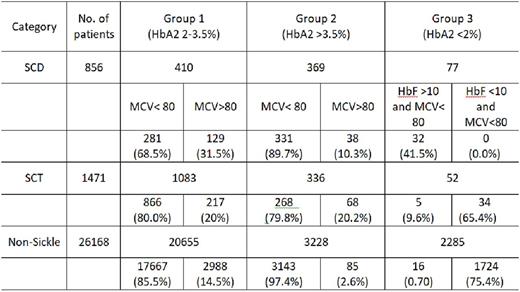Abstract
Introduction:
Sickle cell disease (SCD) is one of the commonest autosomal inherited diseases globally. India has high Sickle cell disease burden, presented with very wide clinical phenotypes. Gujarat state particularly central and south region of state has a high prevalence of the sickle cell anemia. Though being commonly encountered in this region, there are hardly few large scale studies done on sickle cell anemia and its clinical impact on health. With this background in mind, we did this retrospective analysis of laboratory parameters to understand the correlation of HbA2 values in sickle cell population.
Materials and Methods:
This retrospective analysis of Capillary electrophoresis (CE) or High performance liquid chromatography (HPLC) results of total 30845 sample size was done. Study period June 2013 to June 2017. Investigation carried out at 4 different laboratories was reviewed for analysis of Hemoglobin A2 (HbA2) values in Sickle cell population in the central Gujarat region of India. Hematological indices, Solubility tests, were also taken into considerations. Initially, all the data were reviewed and analyzed separately and then they were compiled together and analyzed. Out of 30845, 28495 results were reviewed. Rests were omitted either due to incomplete data. On capillary electrophoresis 19383 tests were conducted, whereas, 9112 tests were conducted on HPLC.
Result
Out of total 28495 samples, 2327 were sickle positive, 846 had HBS >50% (SCD), 1471 had HBS<50% Sickle cell trait (SCT), 26168 no sickle window. With respect to HbA2 value, we divided them further into 3 groups. Group 1 : HbA2 between 2 - 3.5%, Group 2 : HbA2 more than 3.5% and Group 3:HbA2 less than 2%. Further sub analysis of all the 3 groups was done on the basis of MCV. As we assume that high HbF with HbA2<2% may be associated with δ-β thalassemias and low HbF with HBA2<2% may be associated with α-thalassemia, in group 3, Hb F was also considered in sub analysis. The results of the analysis are as depicted in table.
Conclusion
In this retrospective analytic study we found that SCD can be categorized into 3 groups based on HB A2 value, further sub analysis with respect to MCV and HB F value shows, 644 (75.2%) have probability of having co inheritance of Thalassemia (MCV< 80 FL), remaining 212(24.8%)may be representing homozygous SCD with no co inheritance of α or β or δ-β Thalassemia (MCV>80 FL).As we could not find single sample having HBA2 <2% with HBF(<10%) with low MCV in SCD category, raises possibility are we dealing with δ-β Thalassemia in this study population? These patients require further family studies and molecular study to confirm co-association of Thalassemia.There is high possibility that heterogeneity in clinical presentation of SCD patients found in Gujarat may have correlation with low MCV and variability in A2 value (indirect evidence of underlying co-inheritance of Thalassemia). Prospective large cohort study is required to document clinico-pathological correlation.
No relevant conflicts of interest to declare.
Author notes
Asterisk with author names denotes non-ASH members.


This feature is available to Subscribers Only
Sign In or Create an Account Close Modal